
It wasn’t until the 1830s that carbonated beverages became popular by the American public. Until that time, manufacturing carbonated water was a very difficult and time consuming process. English Chemist Joseph Priestley in 1767 discovered a method for creating carbonated water by infusing plain water with carbon dioxide. His method entailed suspending a container of water above a large beer vat. The method was a bit crude, but it worked.
Four years later another chemist, Torbern Bergman invented a similar process in Sweden. A year later, Priestly published a scientific article, “Impregnating Water with Fixed Air,” whereby he describes a process of dripping sulfuric acid onto chalk to produce carbon dioxide gas, and impregnating the gas into agitated water.
Further refinements of these rudimentary processes were undertaken over the next several decades. However, none were particularly economical nor easy.
All that changed when John Matthews pursued improving carbonation processes. An English inventor, Matthews had worked and studied under Joseph Bramah, a renowned giant of the era in British inventions. There, in England, soda water became relished by the public. With Matthew’s improvements, the popularity in England skyrocketed. In addition to his improved methods, Matthews also boosted its popularity by introducing various flavorings to the water.
In 1832 Matthews emigrated to the United States. Upon his arrival, Matthews continued his work with the carbonation processes, and subsequently invented and then patented a revolutionary “apparatus for charging water with carbon dioxide gas.” As with the English public, his flavored soda water quickly proved to be a hit in America.
Quickly thereafter, retail establishments, drug stores, and water purveyors soon adopted Matthews’ process. Demand for Matthews’ equipment blossomed, and his devices virtually made him an overnight success.
Numismatic Specimens
Below please find several soda water tokens as they evolved throughout the 19th century and into the 20th. century.
Hard Times Era
The specimen featured below harkens from Charleston merchant Robert L. Baker. Struck in Feuchtwanger Metal, and minted by Bale & Smith, only a handful of surviving specimens exist. The R.L. Baker token is estimated to be at least R-7 in rarity, and is the first known privately issued token emanating from the state of South Carolina.

Although the pictured token is approximately AG-3 in grade, the author was overjoyed at having such a rare piece added to his cabinet.
During the early times of carbonated water, soda and mineral waters were often used interchangeably. Starting in the mid-19th century, Baltimore quickly became a place where soda water was immensely popular.
One of Baltimore’s early soda water purveyors was Dudley A. Randall. According to early Baltimore directories, Randall operated his business out of Barnum’s City Hotel from 1840-1842. As with other merchants of the time, Randall issued his own token. Struck in German Silver (a variant of Feuchtwanger’s Metal) his token measured a mere 15mm in diameter.
Merchant Era
Soda water purveyor Paul R. Keach was one of the early merchants who offered his soda water product in reusable torpedo bottles. Customers could make their purchase, take the product home, consume their water, and upon return of the bottle, receive a small credit towards their next purchase.

Matchett’s 1847 directory lists Keach’s business on Wine street. This was but merely an alleyway that ran parallel to Baltimore Street on the south, between Charles and Light streets. It’s most probable that Keach maintained a Baltimore Street entrance to his business, as a convenience for his customers.
Below is a P.R. Keach soda water token. Also struck in German Silver, the specimen measures 16mm in diameter with a plain edge.
The fourth token hails from New York City. As with the other tokens, it was also struck in German Silver. By this time, soda water was becoming mass produced, and frequently available for purchase as a take-home bottled product.
This is evidenced by the token’s denomination, where a customer could trade a token for twenty bottles of sodas.
The next token illustrated below was struck for the business of Dr. Zabdiel Silsbee Sampson and his store in Boston Massachusetts. As soda water became more and more popular throughout the United States, various concoctions featuring adjuncts and flavorings evolved.
One concoction which quickly became popular was the ice cream soda. Sampson operated one of Boston’s biggest drugstores. The enterprising druggist advertised all over Boston with signs that declared that any person who did not drink a glass of his soda water “would miss one-half the pleasure of his life!”
Civil War Era
Even with the break-out of the Civil War, the public’s love for soda water did not wane. Merchants during the Civil War area — those mostly in the north — were more than eager to satisfy the public’s thirst.
Below are two soda water tokens. The first is from New York City, and the second from Philadelphia. Both were struck on white metal.
By this era, John Matthews had become a very rich man. His multitudes of patented soda processes and machinery had created a money-making and successful empire. As a means to advertise his company, Matthews commissioned his own storecard medal to be engraved and struck.
Trade Era
After the Civil War, soda water continued to be a popular American libation. By this time, soda dispensaries were standard fixtures in almost every big city drug store. Indeed, by this time, they all had a soda fountain where customers could pull up a stool, sit, and enjoy their favorite soda-water concoction.
In the 1870s, even R.H. Macy’s department store had entered the fray. Producing their own advertising storecards, they issued a token featuring Matthew’s signature trademark, as well as Macy’s familiar star insignia.
Turn of the 20th Century Era
Nearing the turn of the 20th century, even small town America had its share of soda fountains. Every corner druggist had a bar, open for customers to sit and enjoy. By this time, all sorts of adjuncts were being added into soda waters. Eggs, fruit, candy, ice cream, syrups, mints, and herbs were all common ingredients. Moreover, other more exotic and shocking ingredients, were also commonplace. including coca, calisaya and cinchona (quinine), cochina (insect dye), cascara (laxative), acetanilide (analgesic), wormwood (absinthe), and even ambergris (whale dung!).
Below are three tokens hailing from such small town fountains:
Aaron Packard ![]()
Notes and Sources
-
Sundae Best: History of Soda Fountains, Anne Cooper Funderburg, Popular Press, ©2002, pg.27
-
1795-1895. One Hundred Years of American Commerce, Chauncey Mitchell Depew, D.O. Haynes, 1895, pgs.470-474
-
The Standard Manual of Soda and Other Beverages, A. Emil Hiss, G.P. Engelhard & Co, 1897
-
A Treatise on Beverages or The Complete Practical Bottler, Charles Herman Sulz, Dick & Fitzgerald Publishers, 1888
-
Torbern Bergman Biography – by James S. Aber
-
Matchett’s Baltimore Director For 1847’8, R.J. Matchett, 1847
-
The Numismatist Volume 20, 1907, pg.76
-
N.A.R.D. Notes, Volume 22, Issue 18, 1916
-
Directions for impregnating water with fixed air; in order to communicate to it the peculiar spirit and virtues of Pyrmont water, and other mineral waters of a similar nature, Joseph Priestly, 1772
-
Obituary of Robert C. Klinkenberg, Hite Funeral Home, Kendallville, Indiana, November 6, 2003
-
Alexandria Gazette Newspaper, January-February 1900
-
Boyd’s directory of the District of Columbia, W.H. Boyd, 1908
-
‘C.G. Lennon succeeds A.A. Warfield of Alexandria,’ Western Druggist Volume 10, Engelhard, 1888
-
The Era druggists’ Directory Volume 11, D.O. Haynes & Co., 1905
-
The Pharmaceutical Era Volume 19, D. O. Haynes & Co., 1898
-
The City of Alexandria Library System
-
What the Food Law Saves Us From, Dr. Edward A. Ayers, The Worlds Work, August 1907
-
Historic Main Street Kendallsville, Chad Sievers
-
Standard Catalog of United States Tokens 1700-1900 Fourth Edition, Russell Rulau, Krause Publications, ©2004
-
The Library of Congress Digital Archives
- New York’s Crystal Palace & The H.B. West Tokens - November 6, 2019
- Edward Aschermann’s Cigar & Tobacco Tokens - November 2, 2019
- George T. Hussey & His Special Message Tokens - October 30, 2019





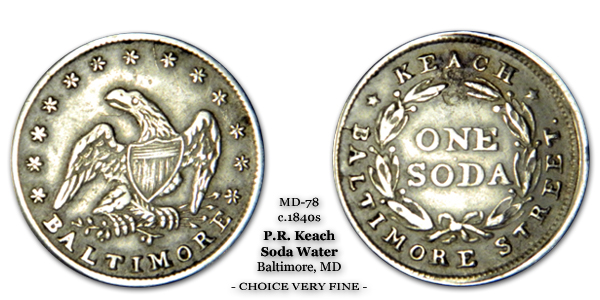
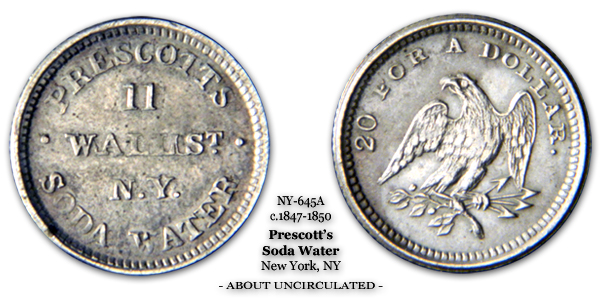








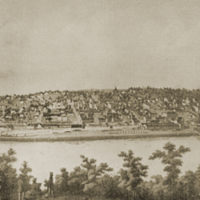
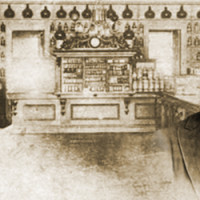
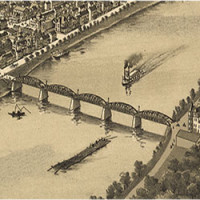
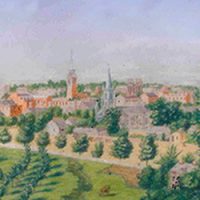
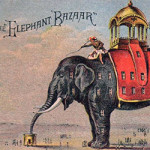
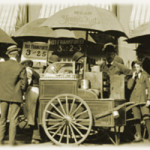
have you ever come across some soda machine plaques? I have found two for John Matthews apparatus’
I have found a soda water facet that looks silver. I know nothing about it but it’s the nicest plumbing you ever saw
Aaron,I am a token and medal dealer from MA. Last week i bought a drug store token in it are 3 tokens that you do not have listed. I thought you would like to know
1. Cargen & Young Druggists ( La Crosse, Wis. )
one glass soda uniface alum. 24mm fine
Cargen & Youngdruggists one glass soda / 301 Main St., La Crosse, Wis alum. 29.5 mm fine
3. Weyrich & Hadraba Plattsmouth, Nebr. Drugs, Kodaks, soda / Good For 10C in trade alum.23 mm
AU ( rev.ie crack )
Thank you very much Robert. I greatly appreciate your information!
Aaron Packard